There is nothing quite as disappointing as getting out on a great day of riding your quad only to have the battery suddenly die. There are several reasons your ATV could suddenly stop working, and it seems many people point their finger (rightfully and wrongfully) at the stator.
But, how do you know if your ATV has a bad stator? If your stator is bad, the battery of your ATV will not charge while the ATV is running. This can be caused by several other problems, however, so the only way to be sure that your stator has gone bad is to perform a series of tests using a multimeter.
In this article, you’ll find everything you need to know about your ATV’s stator, including what it is, what it does, and how do you test to see if it is bad.
A stator is an electrical component of ATVs that is responsible for recharging the battery while the ATV is in use. Think of it like your car’s alternator.
Stators can look quite different depending on the brand of ATV and model, but in general, they consist of an iron core, wire coils, and a cable that allows the stator to be connected to the voltage regulator.
Magnets spin past the coils, which creates an electric current in the wires, which is then passed along to the voltage regulator, and then charges your battery.
There are three different types of stators:
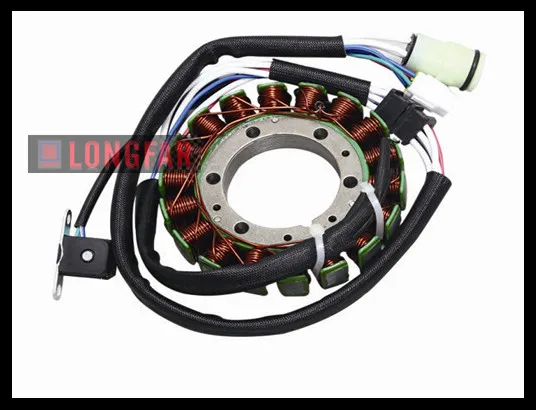
The stator’s primary job is to recharge your ATV’s battery while it is in use, but many ATVs have stators capable of doing more. Your stator might include one or more of the following:
So, looking up a picture of a stator won’t tell you what your specific stator should look like.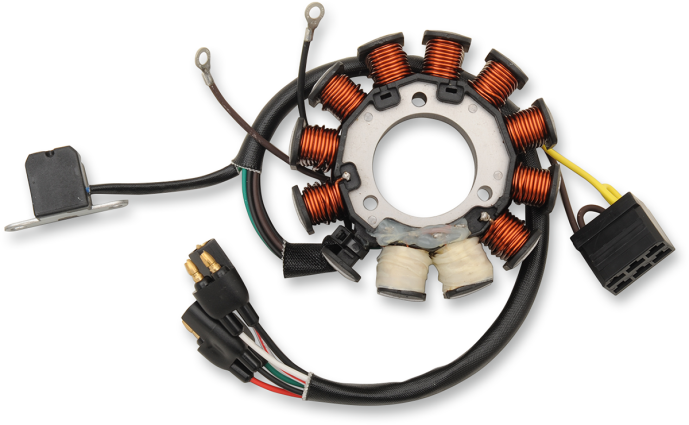 The best place for that information would be your service manual.
The best place for that information would be your service manual.
If your stator is bad, your battery will not charge while you’re driving the ATV. Unfortunately, this can be caused by a variety of other issues with your ATV. Stators tend to be reliable, so before you go replacing the stator, check on these other components:
 This can make it difficult to determine, which is the problem. You can test this with a multimeter to see if it is working.
This can make it difficult to determine, which is the problem. You can test this with a multimeter to see if it is working.If you’re battery, wiring, and voltage regulator are all working correctly, then it is time to check the stator. Some people opt to replace the stator without checking, but testing a stator is easier than replacing it as long as you have a multimeter.
You can get a multimeter for $10-40 on Amazon, so you might as well just have one around for when you need it.
In order to test your stator, you only need two things, neither of which is expensive.
Once you have these two items gathered, you will need to perform some tests to see if your stator is working properly.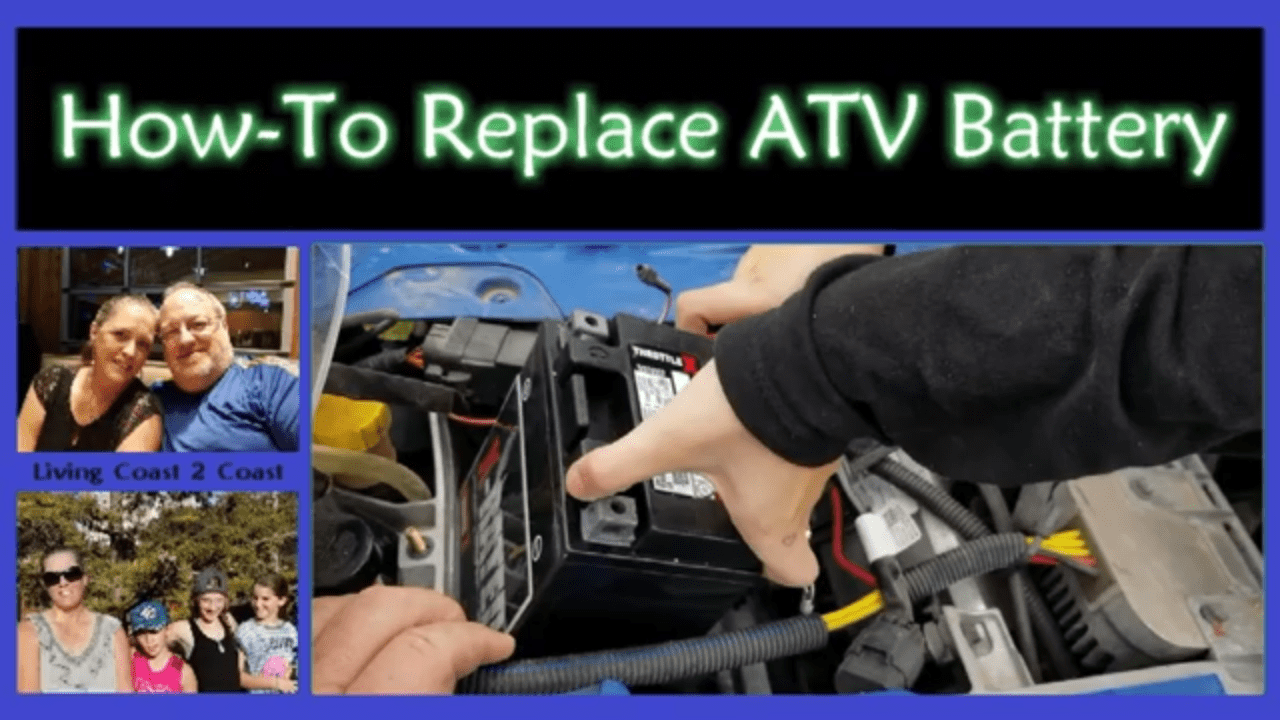 Your service manual will give you the best information on how to do this, but we will go over the basics below.
Your service manual will give you the best information on how to do this, but we will go over the basics below.
For the resistance test, you’ll measure the ohms. You don’t need to worry about which meter lead you use with which pin because polarity doesn’t matter for this test.

This test makes sure that the stator isn’t shorting out to the ground.
When testing the stator with the motor running, you’re going to need to make sure that the battery already has some charge in it. This can be easier said than done when your battery’s charging system isn’t working!
For this test, you’ll measure the volts of AC coming out of the stator while the ATV is running at an rpm determined by your service manual.
You’ll basically do the same thing listed above, but with the motor running at a set rpm. You’ll need a friend to help you with this!
If your ATV’s stator is bad and you aren’t a master at working with electrical components on vehicles, then you’ll have to replace the entire stator.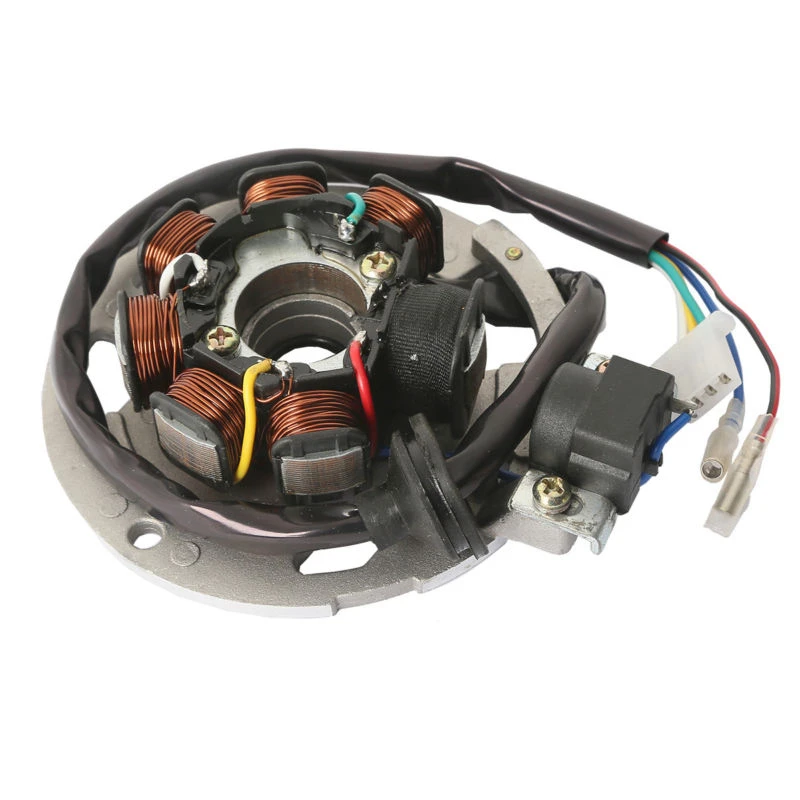
Stators aren’t usually expensive for most ATVs. They will usually cost under $100 for the part and can be significantly less.
The job itself isn’t usually too intense as the stator is typically mounted to the engine in such a way that it is somewhat easy to access. Of course, this will depend on the design of your ATV.
Whether you decide to do the job yourself or hire a professional, it shouldn’t set you back too much.
Unfortunately, replacing a stator is going to be unique, depending on the design of your ATV, so we can’t give you much guidance on how to replace it. The idea is simple, though: remove the old one and attach a new one. Put it all back the way you found it, and you’re done.
Stators can and do go bad, but it isn’t a common occurrence. The only way to know if it’s your stator is to test the stator itself. Luckily, testing is simple. Even those who aren’t mechanically inclined can test their stator by referring to their service manual and following the steps outlined above.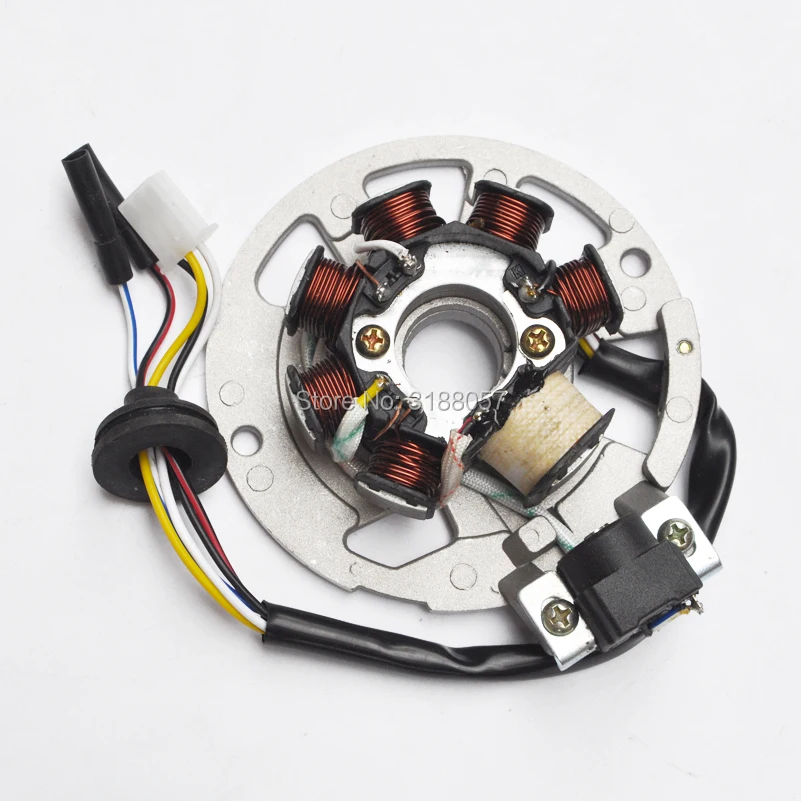 So if you aren’t sure, do the test.
So if you aren’t sure, do the test.
Engine roaring, wind rushing, heart thumping- then all of a sudden, the fun comes to a stop. Your battery on your ATV has died and you are not sure why. Perhaps this is due to a bad stator, or perhaps it is due to something else.
The stator of an ATV works to recharge your battery while your vehicle is running, similar in function to a car’s alternator. When the stator goes bad, your ATV will only run until the battery goes dead, which is not very long. Test the stator with a multi-meter to ensure that this is the problematic part.
Generally speaking, you should be able to narrow down which part on your ATV is causing the issues, especially if your battery is dying rather frequently. The tools that you will need will be relatively inexpensive, so you will just need to run a few tests and determine if your stator is the problem.
Once you have determined this, then there are a few ways to resolve the issue. Continue reading to learn more about what happens when your ATV’s stator goes bad.
Continue reading to learn more about what happens when your ATV’s stator goes bad.
There are only so many things that can slow you down once you begin the thrill of ATV riding. Whether you engage in ATV riding for recreational purposes, use your ATV for work on a farm, or are passionate about ATV as a sport, there are few limitations that can restrict you.
However, when the ATV stops functioning, you will likely be disappointed, frustrated, and in a rush to get your vehicle working again.
One problem part that can cause your ATV to stop working correctly is the stator. The stator works to recharge your ATV’s battery as you drive it.
Similar to the function of an alternator in a car, the stator is very important for ensuring the longevity of your ATV ride. When it goes bad, your battery will not recharge while in use, so your ride will be cut short.
Then, you will only have the option of charging your ATV’s battery while it is not in use, and this will only give you a brief period in which to enjoy riding your ATV. And, of course, you could get stranded when your ATV battery dies as you will not be able to predict the range of time that the off-powered charge will provide for you.
And, of course, you could get stranded when your ATV battery dies as you will not be able to predict the range of time that the off-powered charge will provide for you.
Since the stator recharges the ATV battery while the vehicle is in use, this allows the ATV to be used so long as all of the other parts are working correctly and there is enough fuel.
When the stator goes bad, your thrills of ATV riding will be cut short, and you will surely be over it. In this case, it is important to check out why your stator has gone bad- and, of course, you will need to make sure that the stator is the reason your battery is dying in the first place.
As the stator is made up of a few different components, it is possible that damage to any of these components could cause it to become faulty. The main components of a stator include the cable (connection) and the iron and wire coils. If any of these are dirty or broken, your stator will likely stop working as it should rendering your battery uncharged and you a sitting duck.
Here’s a quick video explaining what a stator is and showing you an example in case you’d like to see it.
Maybe you have your suspicions that your stator is bad, or perhaps you heard of your buddy’s going bad recently and you are wondering if the same problem is happening to your ATV. Fortunately, there are a few ways to tell if your stator is bad.
A few signs that your ATV’s stator is bad include loose, faulty, or dirty connectors and a battery that will charge with a separate charger but not while the ATV is in use.
To test your stator and determine whether it is bad or not, use a multimeter to tell if the appropriate ohms are being produced.
You can find the appropriate range in the ATV’s manual or online.
The main indicator that your stator is bad will be that your battery is not charging- especially if your ATV will charge when on a separate charger but not while the ATV is in use.
In short, this is a high indication because the battery is not the issue in this scenario as it is clearly able to charge. But, if the stator is bad, then it will not charge the battery which will be noticeable when your battery dies when not connected to the alternative charger.
If there are loose, faulty, or dirty connectors with your stator, then this could be the mechanical evidence you need to be able to tell that your stator is bad.
When these components go bad, then the part itself ceases to function as it was designed to do. In this case, you will either have to clean or replace the faulty component, or you will need to replace the entire stator- it depends on your situation.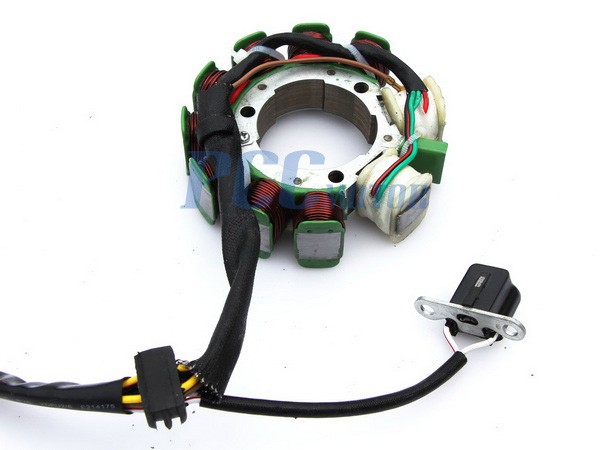
Fortunately, stators themselves generally run under $100, though the parts can be found for way less (often under $20). So, if it is only a small component of your stator that needs to be replaced, then knowing this will save you a bit.
Either way, it is best to have a multimeter on hand to be able to test your stator to ensure that it is the faulty component of your ATV before continuing. Here’s an example Fluke Multimeter (link to Amazon) that I have, to give you an idea of what you’ll need.
If you are unsure whether your battery is faulty or the stator is the problem component of your ATV, there are a few things that you can do. First, you might take your ATV battery to an auto shop and have them test the battery. This will ensure that the battery itself is or is not the problem so that you can eliminate this piece.
If the battery is able to hold a charge but is not recharging while riding, this could indicate that your stator is the component to blame.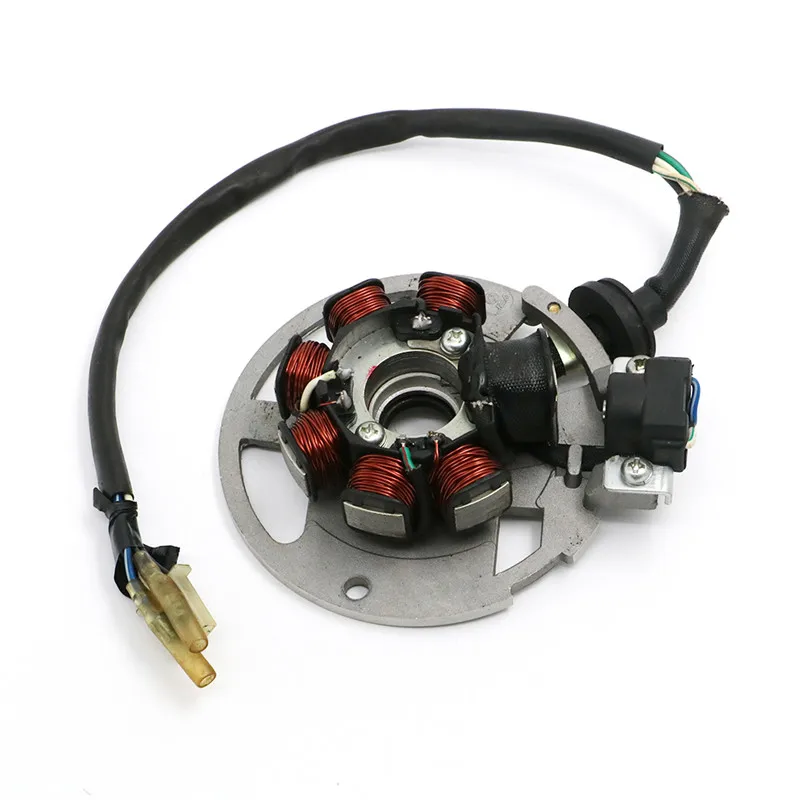 In this case, you should consider testing the stator with a multimeter to verify the energy output and determine whether or not it is functioning as it is supposed to.
In this case, you should consider testing the stator with a multimeter to verify the energy output and determine whether or not it is functioning as it is supposed to.
To test your stator with a multimeter is a relatively simple task. To do so, follow these easy steps:
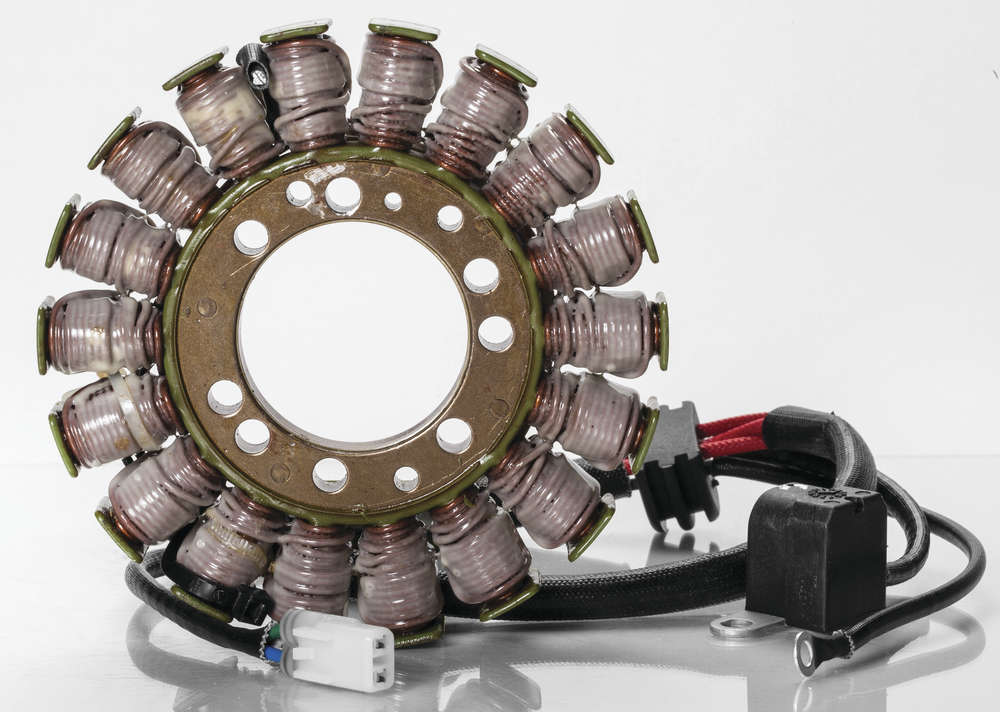
Here’s a video showing the whole process of testing a stator, so you can see it in action.
Once you are confident that the problematic part of your ATV is, in fact, the stator, there are a few options that you can consider. Of course, you will want to have verified with a multimeter test that this is the reason your ATV’s battery is not charging in the first place.
If your ATV’s stator is determined to not be working correctly, then you can either replace the individual parts that are not working, replace the entire stator component, or take your ATV to a professional for them to provide the appropriate action.
Of course, taking your ATV to a professional will generally cost more, but there are limited risks with this option.
Usually they will warranty their work.
Otherwise, if you are attempting to take care of the part yourself and you do not actually know what you are doing, then you might be purchasing unnecessary parts, taking apart pieces of your ATV that you do not know how to handle, and risk a greater cost in the long run as you have to pay someone to fix your mistakes.
You can usually find an ATV Stator (link to Amazon) online, just make sure it will work for your model.
There are plenty of tutorial videos available, though, if you are relatively confident in working with ATV and vehicle parts, so just be sure to make the decision that is right for you and your vehicle.
Here’s a good tutorial video for replacing a stator on an ATV. Not all ATVs will be exactly the same, but these steps are a general guide for changing out a stator.
Hopefully, once you test and replace your stator (or faulty stator components), your ATV’s battery will resume charging while riding, and you can get back to enjoying the thrill of the ride.
Sharing is caring!
 All wires are installed in the correct order. Please do not change the location of the wires in the connector!
All wires are installed in the correct order. Please do not change the location of the wires in the connector! Specifications
Specs Polaris stator OE #4014006 :
Outer diameter: 145mm
Inner diameter: 70mm
Thickness: 18mm
Length of wires from stator to rubber grommet : 1009mm
Other specifications:
Number of wires: 3
Number of connectors: 1
Number of terminals: 3
Line-to-line resistance of generator: 0. 2 ohm +/-20%
2 ohm +/-20%
Voltage/power: 14V/450W
Spare parts used with the Polaris stator with the original OEM#4014006 number:
Polaris Sportsman ATV cover 850/1000: 2203939, 2204781, 1204236, 1204491, 1204491, 1204491, 1204491, 1204491, 1204491, 1204491, 1204491, 1204491, 1204491, 1204491, 1204491, 1204491, 1204491, 1204491, 1204491, 1204491, 1204491, 1204491, 1204491, 1204491, 1204491, 1204491, 1204491, 1204491, 1204491, 12044491 ATV Polaris Sportsman 850/1000: 5813680
Alternator rotor for ATV Polaris Sportsman 850/1000: 4014005
Relay regulator (voltage relay) ATV Polaris Sportsman 850/1000: 4012678
Starter of the ATV Polaris Sportsman 850/1000: 4014946-479
Rotor of the Polaris Sportsman 850/1000 ATV generator: 4015703
Relay regulator (voltage relay) Polaris Sportsman 850/4016868
Starter of ATV Poralis SPORISMA 850/ Installation and Test Guidelines
1. Install the generator stator in its original location.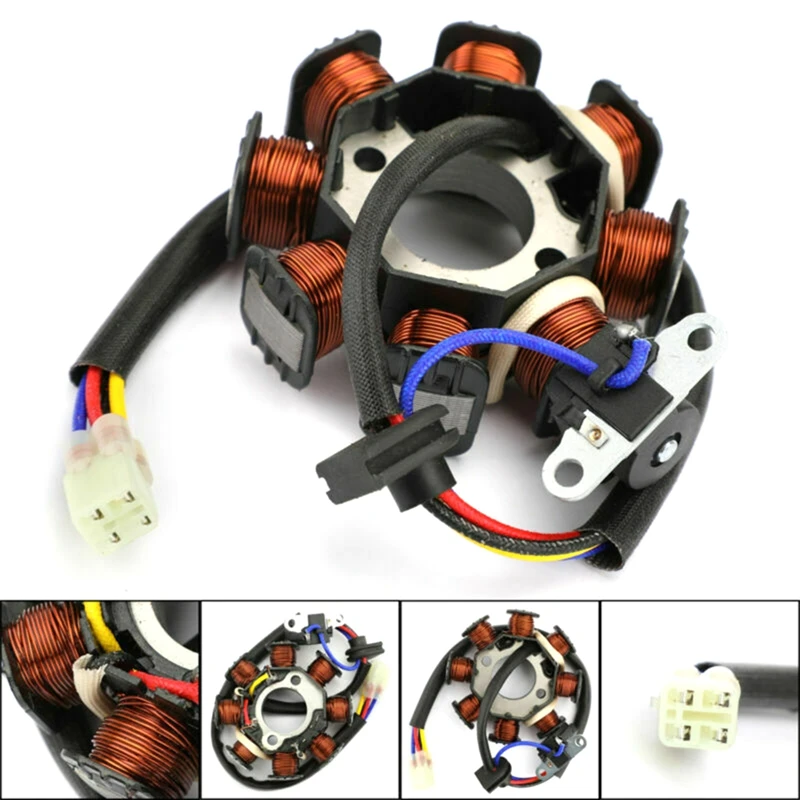 Lubricate all threaded connections of the generator stator mounting with a detachable lock (blue or blue)
Lubricate all threaded connections of the generator stator mounting with a detachable lock (blue or blue)
2. If necessary, replace any burnt or corroded regulator/rectifier relay connectors.
We strongly recommend not to connect the generator stator directly (without a connector) to the regulator relay: the connector acts as a buffer, protection
3. Check, repair any signs of wiring malfunction
4. We recommend using high temperature dielectric grease for all connectors of the electrical circuit of your motorcycle / ATV / snowmobile
5. Test the stator for a winding short circuit. To do this, use the multimeter in the normal continuity position
5. Test the stator for phase to phase voltage. To do this, use the multimeter in the AC position:
- Without connecting the alternator stator terminal to the governor relay terminal, start the motorcycle/ATV/snowmobile. Set the switch on the multimeter to the ACV or V (alternating voltage) sector and measure the phase-to-phase voltage from the generator stator, alternately measuring the voltage output by the generator between 1 and 2, 2 and 3, 1 and 3 phases. At 1000 rpm, the “working” voltage is between 12 V and 22 V. At 3000 rpm – 5000 rpm, the “working” voltage is between 35 V and 80 V. Note that both otherwise, the interphase (1 and 2, 2 and 3, 1 and 3) voltage must be the same
At 1000 rpm, the “working” voltage is between 12 V and 22 V. At 3000 rpm – 5000 rpm, the “working” voltage is between 35 V and 80 V. Note that both otherwise, the interphase (1 and 2, 2 and 3, 1 and 3) voltage must be the same
6. If everything is as described above, the generator stator is in good condition and can be connected to a common electrical circuit
7. You make further and final measurements of the degree of charge at the battery terminals by setting the multimeter switch to the DCV or V (constant voltage) sector, by comparing the values with the manual for your motorcycle/ATV/snowmobile. These values should be considered "working" if they are in the range from 12.9 V to 15.0 V
": https://generator-pro24.ru/kontakty/
Attention
Battery condition is extremely important! No stator is able to compensate for a dead or dead battery. A bad battery can cause damage to the generator stator. Make sure your battery is charged, fully functional and capable of handling the load.
Or just replace it. Always start all tests with a 100% working battery!
Conditions for the repair of motorcycle generators in Generator-Pro24
We do not go to the client's address, we do not have a courier service and delivery service. The client brings his own generator. If you are from another city or region of Russia, when placing an order on our website, you will be asked to choose the methods of transferring your faulty generator (SDEK, Russian Post and other transport companies). To contact us, use any of the communication methods available to you from those indicated on our website
The deadline for the execution of the order is set by us on the spot, at the time of the transfer of the faulty generator (we determine the degree and nature of the damage, which to a large extent determines the time for the upcoming repair). Or by phone, if we understand that we are dealing with a regular case. Usually the repair period does not exceed four days
We strongly ask you to remove the stator winding of the generator without cutting off the wire loop connecting the generator phases and ask you to leave the generator stator connector intact. Only in this way can we consider the option of replacing your faulty generator with a refurbished generator from our warehouse, and you will significantly save time spent without your motorcycle / ATV / snowmobile
Only in this way can we consider the option of replacing your faulty generator with a refurbished generator from our warehouse, and you will significantly save time spent without your motorcycle / ATV / snowmobile
Attention! We do not sell remanufactured generators that we have in stock. We exchange them for faulty generators of our clients on the same day of contact (the conditions and cost of the exchange are indicated on our website )
it is intact, and the battery is fully functional. If any of the above does not correspond to the norm, then both you and we will not achieve the desired result. Therefore, before contacting us for help, have your motorcycle / ATV / snowmobile diagnosed by a motorcycle workshop if you cannot do it yourself
We do not remove and install, we do not diagnose and we do not issue a verdict on the condition of your equipment. We are dealing with an already established malfunction and fixing it
Turning to us, you must be sure that by handing over your faulty generator to us, you will receive it in absolutely good condition and having the parameters that are provided for by the manual for your model of motorcycle, ATV or snowmobile
 .. 92020 ATV ATV Polaris SPORTSMAN TOURING 570 EFI/ EPS
.. 92020 ATV ATV Polaris SPORTSMAN TOURING 570 EFI/ EPS Description
1. In the rewound magneto, generator stator of the ATV Polaris Sportsman 570/ 450 (660W) ATV, enameled wire of Russian production is used, resistant to a temperature of 200 ° C
2. The stator is impregnated with an oil-petrol-resistant hardener (compound)
3. When repairing
4. After repair, the client receives the stator complete with wire, connector, rubber bushing, crankshaft position sensor (if provided)
5. The repaired stator may have a different color code for the phase wires than on the original. All wires are installed in the correct order. Please do not change the location of the wires in the connector!
6. The refurbished stator is a direct-use part that must be used as such, in accordance with the manufacturer's original parts catalog
7. Generator-Pro24 guarantees that after repairing the stator, all its characteristics will be 100% consistent with the original characteristics provided by the manufacturer technology. nine0009 8. All images of repaired stators posted on the site https://generator-pro24.ru/ are made in the Generator-Pro24 workshop and are an illustration of how a previously burnt stator looks like after repair and direct replacement of part of its components in the process of restoration work
nine0009 8. All images of repaired stators posted on the site https://generator-pro24.ru/ are made in the Generator-Pro24 workshop and are an illustration of how a previously burnt stator looks like after repair and direct replacement of part of its components in the process of restoration work
9. The refurbished stator is identical to the original OEM # 4014839 in number of turns and diameter of the enameled wire, ready to install on the following ATV models: Polaris ACE 900 EFI EPS Polaris ACE 900 EPS XC Polaris ACE 900 EPS XC Polaris FARMHAND 450 HD 2X4 Polaris SPORTSMAN 450 HD 2X4 Polaris SPORTSMAN 450 HO Polaris SPORTSMAN 450 HO Polaris SPORTSMAN 450 HO Polaris SPORTSMAN 450 HO 2X4 MD Polaris SPORTSMAN 450/570 EFI MD Polaris SPORTSMAN 450/570 EFI MD Polaris SPORTSMAN 450/570 EPS QUAD Polaris SPORTSMAN 450/570 EPS ZUG Polaris SPORTSMAN 450/570 TRACTOR Polaris SPORTSMAN 570 6X6 SPORTSMAN 570 6X6 TRACTOR, Polaris SPORTSMAN 570 6X6 TRACTOR, Polaris SPORTSMAN 570 EFI, Polaris SPORTSMAN 570 EFI, Polaris SPORTSMAN 570 EFI, Polaris SPORTSMAN 570 EFI EPS EU, Polaris SPORTSMAN 570 EFI EPS EU, Polaris SPORTSMAN 570 EFI EPS EUSMAN SP 570 EFI EPS FOREST QUAD, Polaris SPORTSMAN 570 EFI EPS MD, Polaris SPORTSMAN 570 EFI HD, Polaris SPORTSMAN 570 EFI HD, Polaris SPORTSMAN 570 EFI HD, Polaris SPORTSMAN 570 EFI MD, Polaris SPORTSMAN 570 EFI TOURING EU, Polaris SPORTSMAN 570 EFI UTE, Polaris SPORTSMAN 57 0 EFI UTE, Polaris SPORTSMAN 570 EFI UTE HD, Polaris SPORTSMAN 570 EFI UTE MD, Polaris SPORTSMAN 570 EFI UTE TRACTOR, Polaris SPORTSMAN 570 EPS TRACTOR, Polaris SPORTSMAN 570 EPS TRACTOR SP, Polaris SPORTSMAN 570 EPS UTE QUAD, Polaris SPORTSMAN 570 EPS ZUG Polaris SPORTSMAN 570 EPS ZUG Polaris SPORTSMAN 570 EPS ZUG SP Polaris SPORTSMAN 570 SP Polaris SPORTSMAN 570 SP Polaris SPORTSMAN 570 SP Polaris SPORTSMAN 570 SP Polaris SPORTSMAN 570 SP EPS QUAD Polaris SPORTSMAN TOURING 570 EFI/EPS, Polaris SPORTSMAN TOURING 570 EFI/EPS, Polaris SPORTSMAN TOURING 570 EFI/EPS, Polaris SPORTSMAN TOURING 570 Polaris SPORTSMAN TOURING 570 EFI/EPS MD, Polaris SPORTSMAN TOURING 570 EPS EU, Polaris SPORTSMAN TOURING 570 EPS TRACTOR, Polaris SPORTSMAN TOURING 570 EPS TRACTOR, Polaris SPORTSMAN TOURING 570 EPS TRACTOR SP, Polar is SPORTSMAN TOURING 570 QUAD EPS, Polaris SPORTSMAN TOURING 570 SP, Polaris SPORTSMAN TOURING 570 SP, Polaris SPORTSMAN TOURING 570 SP, Polaris SPORTSMAN TOURING 570 SP, Polaris SPORTSMAN TOURING 570 SP MD Polaris SPORTSMAN X2 570 EFI EPS, Polaris SPORTSMAN X2 570 EFI EPS, Polaris SPORTSMAN X2 570 EPS TRACTOR
sportsman 450 hd 2×4, sportsman 450 ho, sportsman 450 ho 2×4 md, sportsman 450/570 efi md, sportsman 450/570 eps quad, sportsman 450/570 eps zug, sportsman 450/570 tractor, sportsman 570 6×6, sportsman 570 eu, sportsman 570 efi ute, sportsman 570 efi ute hd, sportsman 570 efi ute md, sportsman 570 efi ute tractor, sportsman 570 eps tractor, sportsman 570 eps tractor sp, sportsman 570 eps ute quad, sportsman 570 eps zug, sportsman 570 eps zug sp, sportsman 570 sp, sportsman 570 sp eps quad, sportsman 570 sp eps tractor, sportsman 570 sp md, sportsman touring 570 efi/eps, sportsman touring 570 efi/eps md, sportsman touring 570 eps eu, sportsman touring 570 eps tractor , sportsman touring 570 eps tractor sp, sportsman touring 570 quad eps, sportsman touring 570 sp, sportsman touring 57 0 sp md, sportsman touring 570 tractor efi eps, sportsman x2 570 efi eps, sportsman x2 570 efi eps eu, sportsman x2 570 eps eu, sportsman x2 570 eps md, sportsman x2 570 eps tractor
Specifications
Specs Polaris stator OE #4014839 :
Outer diameter: 126mm
Inner diameter: 54mm
Thickness: 19mm
Length of wires from stator to rubber grommet: 809mm
Other specifications:
Number of wires: 3
Number of connectors: 1
Number of terminals: 3
Line-to-line resistance of generator: 0. 4 ohm +/-20%
Parts used with Sportsman Stator OE# 4014839:
Polaris ATV Alternator Rotor: 4014688
Installation and Test Guidelines
1. Install the generator stator in its original location. Lubricate all threaded connections on the generator stator mount with
2 connector. Replace any burnt or corroded regulator/rectifier relay connectors as needed. nine0009 We strongly recommend that you do not connect the generator stator directly (without a connector) to the regulator relay: the connector acts as a buffer, protection
3. Check, eliminate any signs of wiring malfunction
4. We recommend using high temperature dielectric grease for all connectors of the electrical circuit of your motorcycle / ATV / snowmobile
5. Test the stator for a winding short circuit. To do this, use a multimeter in the normal continuity position
5. Test the stator for phase-to-phase voltage. To do this, use the multimeter in the AC measurement position:
- Without connecting the generator stator terminal to the regulator relay terminal, start the motorcycle / ATV / snowmobile. Set the switch on the multimeter to the ACV or V (alternating voltage) sector and measure the phase-to-phase voltage from the generator stator, alternately measuring the voltage output by the generator between 1 and 2, 2 and 3, 1 and 3 phases. At 1000 rpm, the “working” voltage is between 12 V and 22 V. At 3000 rpm – 5000 rpm, the “working” voltage is between 35 V and 80 V. Note that both otherwise, the interphase (1 and 2, 2 and 3, 1 and 3) voltage must be the same
6. If everything is as described above, the generator stator is in good condition and can be connected to a common electrical circuit
7. You make further and final measurements of the degree of charge at the battery terminals by setting the multimeter switch to the DCV or V (constant voltage) sector, by comparing the values with the manual for your motorcycle/ATV/snowmobile. These values should be considered "working" if they are in the range from 12.9 V to 15.0 V
": https://generator-pro24.ru/kontakty/
Attention
Battery condition is extremely important! No stator is able to compensate for a dead or dead battery.
A bad battery can cause damage to the generator stator. Make sure your battery is charged, fully functional and capable of handling the load. Or just replace it. Always start all tests with a 100% working battery!
Conditions for the repair of motorcycle generators in Generator-Pro24
We do not go to the client's address, we do not have a courier service and delivery service. The client brings his own generator. If you are from another city or region of Russia, when placing an order on our website, you will be asked to choose the methods of transferring your faulty generator (SDEK, Russian Post and other transport companies). To contact us, use any of the communication methods available to you from those indicated on our website
The deadline for the execution of the order is set by us on the spot, at the time of the transfer of the faulty generator (we determine the degree and nature of the damage, which to a large extent determines the time for the upcoming repair). Or by phone, if we understand that we are dealing with a regular case. Usually the repair period does not exceed four days
We strongly ask you to remove the stator winding of the generator without cutting off the wire loop connecting the generator phases and ask you to leave the generator stator connector intact. Only in this way can we consider the option of replacing your faulty generator with a refurbished generator from our warehouse, and you will significantly save time spent without your motorcycle / ATV / snowmobile
Attention! We do not sell remanufactured generators that we have in stock. We exchange them for faulty generators of our clients on the same day of contact (the conditions and cost of the exchange are indicated on our website )
it is intact, and the battery is fully functional. If any of the above does not correspond to the norm, then both you and we will not achieve the desired result. Therefore, before contacting us for help, have your motorcycle / ATV / snowmobile diagnosed by a motorcycle workshop if you cannot do it yourself
We do not remove and install, we do not diagnose and we do not issue a verdict on the condition of your equipment.